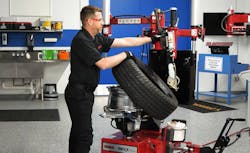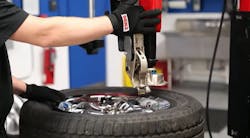Those who use them know tire changers enable efficient and precise mounting and dismounting of tires in auto and commercial vehicle shops. While the speed at which technicians can perform work at the wheel end is the reason you’d use one, it’s important to emphasize safety first. Improper use and neglecting safety guidelines can cause serious accidents, which will certainly grind work to a halt. So let’s examine the best practices and guidelines to safely operate a tire changer.
On a general level it’s also important to understand the types of dangers present.
- Low Hazard: Minor issues like loose clothing can escalate into significant dangers if ignored.
- Medium Hazard: Situations such as rusty or damaged wheels that require careful inspection.
- High Hazard: Critical risks like mismatched tires and rims, which can result in catastrophic tire explosions.
Identifying hazards
It’s important that all operators know how to spot potential dangers before using the tire changer. Hazards can range from damaged beads and mismatched tires to improper inflation and operator errors. Each risk poses the potential for serious injury or even death.
Make sure the safety instructions provided by manufacturers are easy to access.
be aware of common hazards and how to address them:
- Damaged Beads: Stop and replace the tire if bead damage occurs during mounting.
- Rusty Wheels: Thoroughly inspect wheels for rust, especially in the bead seat area.
- Mismatched Tires and Wheels: Verify that tire and wheel diameters match exactly to prevent dangerous explosions.
- Improper Inflation: Always adhere to manufacturer-recommended inflation pressures.
- Standing Clear: Never position any part of your body over the tire changer during inflation.
If you’re looking for step-by-step guidance on how to use a tire changer, Coats Company offers comprehensive resources to help you operate their equipment efficiently. To learn more about Coats Company’s commitment to safety, visit coatscompany.com or consult their product manuals.
There’s plenty of visual aids online as well. Coats, for example, provides in-depth YouTube Master Class videos to show how to safely operate the machine and offer tips like getting into the habit of treating every tire like it has a TPMS sensor on it.
Recognizing these levels and taking preventive measures can significantly reduce the likelihood of accidents.
And when in doubt, always turn to the R.I.M. program (Read, Inspect, Mount), which offers a straightforward approach to tire servicing safety:
Read: Always verify the tire size and ensure it matches the rim. Mounting the wrong size tire can lead to catastrophic accidents, including tire explosions.
Inspect: Examine both the tire and the rim for any damage. Look for rust, cracks, or tough spots that could prevent proper seating. Avoid using damaged tires or rims until they have been approved by a supervisor.
Mount: When mounting a tire, follow these safety tips:
- Never lean over the tire during inflation.
- Avoid inflating the tire beyond 40 psi if the bead does not seat properly.
- If the tire fails to seat, deflate it and inspect for issues before trying again.
Following the R.I.M. program ensures a systematic approach to tire servicing, minimizing the risks of accidents.
PPE to wear while using a tire changer
- Wear durable clothing and avoid loose-fitting garments to prevent entanglement in machinery.
- Leather gloves will protect hands from sharp edges and worn tires.
- Steel-Toed Shoes will mitigate potential foot injuries from dropped tires or the machine.
- Safety glasses or face shields should be worn to protect against debris during tire servicing.
- Back Belts are useful to reduce strain when lifting tires
- Hearing Protection is always recommend when working in a noisy environments.
By equipping operators with the right gear, shops can enhance safety and reduce the likelihood of workplace injuries.
Shop owners responsibility for safety
By following these guidelines, shop owners can ensure both machine and operator safety:
- Follow all installation instructions and ensure compliance with local, state, and federal codes.
- Conduct regular inspections to verify the correct functioning of the equipment.
- Train operators thoroughly on safe and proper tire changer usage.
- Use only authorized replacement parts for maintenance.
- Keep safety instructions and decals visible and accessible at all times.
Failing to uphold these responsibilities can compromise safety and increase the risk of accidents.
Bead sealing, seating, and inflation
Bead sealing
Bead sealing captures air pressure between the tire and the rim. Initial bead sealing typically requires 1 to 2 psi.
Bead seating
Bead seating involves securing the tire on the rim. This process usually begins with the long tapered side of the wheel. If a tire requires more than 40 psi for bead seating, use a safety cage as an additional precaution.
Inflation
After bead seating, inflate the tire to the manufacturer’s recommended pressure. For most automobile tires, this range is between 24 and 45 psi. Overinflation can lead to severe risks, so never exceed the recommended limits.
Final thoughts
Safety is a shared responsibility between shop owners, operators, and equipment manufacturers. By understanding hazard levels, using appropriate protective equipment, and adhering to safety programs like R.I.M., operators can mitigate risks associated with tire changers. Remember, a commitment to safety not only protects employees but also enhances productivity and trust in your automotive shop.
About the Author
Kyle Harris
Kyle Harris, senior product manager for tire changers and balancers at The Coats Company, is a passionate industry veteran with over a decade of experience. TIA-certified in commercial and automotive tire service, Kyle continually advances his expertise, most recently earning his ASE badge as an ADAS Advanced Level Specialist. His technical acumen is unmatched at Coats.

